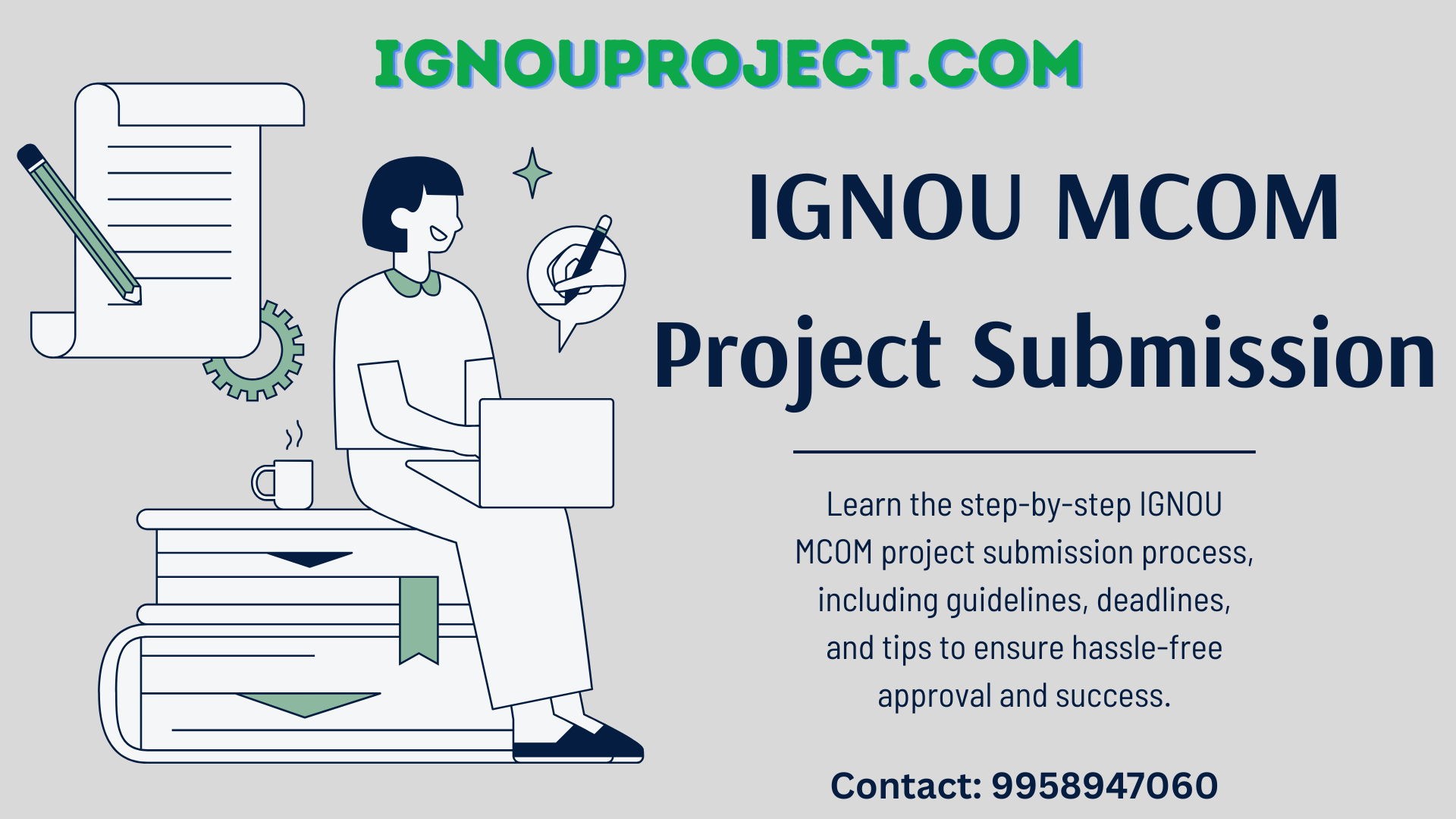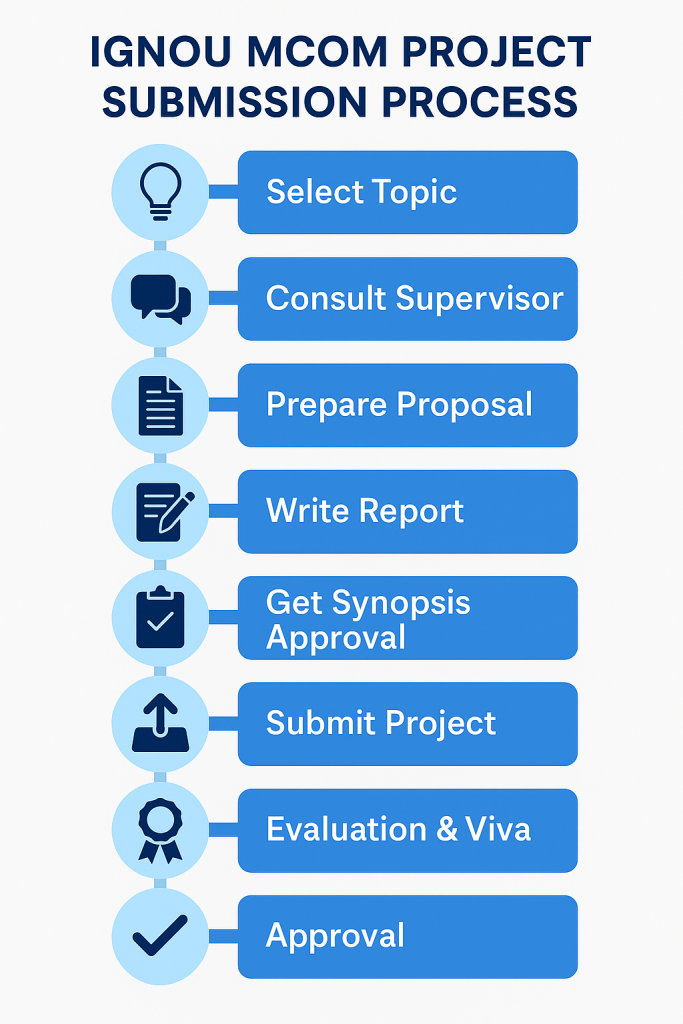
The IGNOU MCOM project submission process consists of numerous critical components. First, students must choose a project topic that relates to their area of interest and specialty within the MCOM program. Once the topic has been chosen, students must create a project proposal or summary that includes the title, objectives, methods, and anticipated outcomes. This synopsis has been submitted to the study center for approval. If the synopsis is approved, students can begin working on the real project.
Students must undertake in-depth research, collect data, and analyze the results in accordance with the accepted plan. After finishing the study, they compile the project report, which must follow the IGNOU criteria. The report must be typed, structured, and bound appropriately.
When the report is completed, students submit it to their regional center or study center, along with any appropriate forms and papers, such as the project approval letter and declaration form. They may also be required to take a viva or oral examination to defend their project. The project must be successfully submitted and evaluated in order to obtain the credits required to finish the MCOM program.
What are the key steps involved in the IGNOU MCOM project submission process?
The key steps involved in the Mcom project submission process are as follows:
- Topic Selection: Students select a project topic related to their area of interest in the MCOM program. The topic should follow the IGNOU project guidelines.
- Synopsis Preparation and Submission: After selecting a topic, students create a project proposal or synopsis that covers the title, objectives, methods, and projected outcomes of the study. This synopsis is then presented to the study center for approval.
- Approval of Synopsis: The synopsis is reviewed by the university or study center, and once approved, students receive a formal confirmation to proceed with the research.
- Research and Data Collection: Students conduct in-depth research and gather data as outlined in the approved synopsis.
- Project Report Preparation: After completing the research, students write the project report, adhering to IGNOU’s formatting and presentation guidelines. Check out: IGNOU MCOM Project Guidelines for MCOP 001 Course.
- Submission of Project Report: The final report, along with necessary documents such as the project approval letter and declaration form, is submitted to the regional or study center.
- Viva Voce (if required): Some projects may require students to attend a viva or oral defense as part of the evaluation process.
- Evaluation: The project is evaluated, and the result is included in the final grade for the MCOM program.

Preparing and Submitting Your MCOM Project Synopsis
Your synopsis (project proposal) acts as a blueprint and must be approved before you write the full report. Follow these steps:
- Draft & Review with Supervisor: Write the synopsis draft based on the proposal outline above. Have your guide review it and suggest improvements.
- Revise as Needed: Incorporate the supervisor’s feedback to sharpen objectives and scope.
- Get Supervisor’s Signature: Once finalized, your supervisor must sign (or endorse) the synopsis. A signature means your guide approves the plan.
- Submit for Approval: Send the signed synopsis and project proposal to IGNOU for official clearance. Nowadays, many regions allow online submission through IGNOU’s portal. Alternatively, you may have to mail or deliver it in person. Check your Regional Centre’s or School’s email for instructions.
- Wait for Feedback: IGNOU will review your synopsis (this may take 1–2 months). They might accept it, suggest changes, or reject it. If it’s rejected, you must revise and resubmit. If accepted, you can proceed with confidence.
Remember: A signed synopsis isn’t a guarantee of acceptance—IGNOU faculty may still request changes. Use this as an opportunity to refine your work early. ✏️
Final Project Submission 💼
Once your synopsis is approved and your report is complete, it’s time to submit the final project. Steps include:
- Deadlines: Always keep an eye on submission deadlines (usually twice a year). Late or incomplete submissions will not be accepted. Use IGNOU’s online resources or contact your Regional Centre for the exact date each year.
- Online Submission (if available): Check if IGNOU’s online portal is open for project uploads for your term. If so, upload your single PDF file of the entire project (including cover page, certificate, synopsis, etc.) as per the portal instructions.
- Hard Copy Submission: If online submission isn’t an option, prepare two hard-bound copies of your project. Ensure each copy includes:
- Approved synopsis (proposal proforma) attached.
- Signed original copy of the synopsis.
- Certificate of originality duly signed by you and your supervisor.
- Copy of the fee payment receipt (if IGNOU requires a project evaluation fee).
Addressing: Send your project to the IGNOU head office in Maidan Garhi, Delhi, via speed post or courier. Be sure to send to the correct department/school. For example, Social Science projects go to the School of Social Sciences, while Commerce projects may go to SOMS (School of Management Studies). Check the IGNOU website or guidelines for the exact postal address of your department.
Can the IGNOU MCOM project submission process be completed online, or is it mandatory to submit the project physically?
MCOM project submission often requires students to physically deliver their project papers to their regional or study centers. Some aspects of the procedure, such as submitting the project summary and receiving permissions, may be expedited using online platforms, depending on IGNOU’s current regulations and technical improvements.
While students can often obtain relevant paperwork and guidelines on the IGNOU website, and they may be able to connect with their supervisors or academic counselors online, the final project report submission typically requires a physical copy. This is necessary for documentation and verification purposes.
To ensure the most recent protocols and any potential revisions regarding online submissions, students can visit the official IGNOU website or contact their study center for particular MCOM project submission guidelines.
How do students track the approval status of their synopsis in the IGNOU MCOM project submission process?
Students can track the approval status of their synopsis in the MCOM project submission process through several methods:
- Official Communication: After submitting the synopsis, students should regularly check their email for any communications from their study center or the university. Approval notifications or requests for revisions are often sent via email.
- Contacting the Study Center: Students can reach out directly to their study center or the academic supervisor assigned to them. This can be done through phone calls or visits, where they can inquire about the status of their synopsis approval.
- Online Student Portal: IGNOU provides an online student portal where students can log in to access various services, including tracking their submission status. By checking this portal, students may find updates related to their synopsis.
- Follow-Up: If students do not receive any updates within a reasonable timeframe, it is advisable to follow up with the study center to ensure their synopsis is being processed.
What guidelines should be followed for preparing the report during the IGNOU MCOM project submission process?
When preparing the report for the IGNOU MCom project submission, students should adhere to the following guidelines:
Format and Structure:
The project report should typically include the following sections: Title Page, Acknowledgments, Table of Contents, Introduction, Literature Review, Research Methodology, Data Analysis, Findings and Discussion, Conclusion, Recommendations, and References. Each section should be clearly labeled.
Page Layout:
Use A4 size paper with margins of 1 inch on all sides. The text should be typed in a readable font, such as Times New Roman or Arial, with a font size of 12 for the main text and 14 for headings. Line spacing should generally be set to 1.5 or double spacing.
Length:
The report should usually be between 60 to 100 pages, excluding appendices and references. It’s essential to check the specific guidelines from IGNOU, as requirements may vary.
Referencing Style:
Follow a consistent referencing style (APA, MLA, Chicago, etc.) for citing sources and preparing the bibliography. All references used in the report should be listed comprehensively.
Clarity and Precision:
The language should be clear, concise, and free of grammatical errors. Students should avoid jargon and ensure that complex ideas are explained adequately.
Tables and Figures:
Any tables, charts, or figures used should be labeled correctly and included in the report. They should be referenced in the text and positioned close to where they are discussed.
Proofreading:
Prior to submission, the report should be thoroughly proofread for typographical errors and formatting issues.
What are the common reasons for delays in the IGNOU MCOM project submission process?
Common reasons for delays in the IGNOU MCom project submission include the following:
- Topic Selection Issues: Students may struggle to choose an appropriate and relevant project topic, leading to extended time in the initial stages.
- Approval Delays: The time taken for the approval of the project synopsis can vary, and if students submit their synopses close to deadlines, they may face delays in receiving feedback.
- Research Challenges: Difficulties in gathering data or accessing necessary resources can hinder the progress of the research, causing delays in report writing.
- Time Management: Poor time management by students often leads to last-minute rushes, which can result in incomplete or poorly prepared project reports.
- Academic Workload: Balancing project work with other academic responsibilities, such as assignments and examinations, can lead to delays in completing the project.
- Technical Issues: Students may encounter technical problems, such as software issues or internet connectivity problems, especially when conducting online research or preparing digital submissions.
- Personal Challenges: Personal circumstances, including health issues or family responsibilities, can also impact a student’s ability to complete the project on time.
- Inadequate Guidance: Lack of support or guidance from supervisors or faculty can leave students uncertain about their project direction, contributing to delays.
What is the role of the academic supervisor in the IGNOU MCOM project submission process?
The academic supervisor plays a crucial role in the IGNOU MCom project submission process by providing guidance and support throughout the student’s research journey. Their main responsibilities include:
Approving the Synopsis:
The supervisor reviews and approves the project synopsis, ensuring the topic is relevant, feasible, and aligned with the academic objectives of the MCom program.
Guidance on Research:
Supervisors offer valuable advice on formulating research questions, selecting appropriate methodologies, and gathering data. They help students refine their ideas and direct their research efforts toward meaningful and achievable outcomes.
Feedback on Drafts:
Throughout the project, the supervisor reviews drafts of the student’s work, offering constructive feedback on structure, content, and research quality. This feedback helps students improve their report and meet IGNOU’s academic standards.
Monitoring Progress:
Supervisors monitor the student’s progress, ensuring that they adhere to the project timeline and maintain focus on the objectives.
Assisting with Challenges:
If students encounter difficulties during their research or writing, the supervisor provides solutions and guidance to overcome obstacles, whether related to research methods or data interpretation.
Final Review:
Before submission, the supervisor conducts a final review of the project report to ensure it meets the required standards for submission and evaluation.
For more guidance on supervisor roles and documentation, see Role of IGNOU MCOM Project Supervisor.

